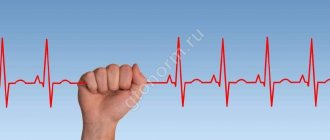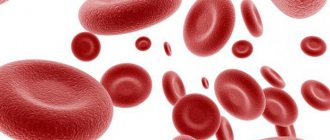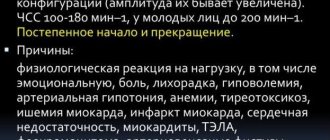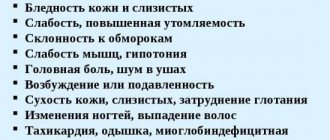Many people of different genders and ages struggle with the common problem of excess weight and are faced with an unpleasant situation when everyday exercise does not bring the desired effect, and the extra pounds do not want to leave them.
Only a small part thinks that in order to achieve the required goal, it is advisable to take into account the individual characteristics of the body, and in particular the number of heartbeats during the training period.
For each person, the heart rate for burning fat is calculated individually, which is why training may not bring the desired effect, since it takes place with insufficient heart beats per minute or exceeding the norm. This review will discuss the main aspects regarding the number of heart beats per minute (HR) per minute for men and women depending on different sports.
Metabolism in the body
The basis for the functioning of each organism is constant metabolism. The source of energy is organic substances in the form of proteins, fats and carbohydrates, which are broken down in the body under the influence of enzymes. The speed of these processes depends, among other things, on external circumstances and can be adjusted through physical activity.
When a person exercises at moderate intensity for a short period of time, less than 30 minutes, the body primarily uses carbohydrates (onosaccharides, disaccharides and polysaccharides) as fuel. In the digestive tract, polysaccharides (starch, glycogen; fiber and pectin are not digested in the intestine) and disaccharides, under the influence of enzymes, are broken down into monosaccharides (glucose and fructose), which are absorbed into the blood in the small intestine. A significant portion of monosaccharides enters the liver and muscles and serves as material for the formation of glycogen.
If the training time is more than 45 minutes, at low to medium intensity, the process of lipolysis begins, the metabolic process of breaking down fats into their constituent fatty acids. Lipolysis is the most important energy process in the cell, which ensures the synthesis of the largest amount of ATP (a universal source of energy for all biochemical processes occurring in living systems).
If the intensity of the workout increases, the body's need for oxygen also increases, which helps glycogen break down faster. During intense exercise, the body can quickly obtain energy only from glycogen due to the release of ATP molecules, all oxygen is reoriented to it. Glycogen reserves in the body are an order of magnitude lower than fat reserves, making it much more beneficial for the body to break down fats.
Please note: in order to get rid of extra pounds, the most effective and efficient option is aerobic exercise for 30-45 minutes: race walking, exercise in a swimming pool, running.
How the body burns fat
The human body converts carbohydrates and fats into energy, which our cells need. Energy production is a constant process, but the source of energy can change depending on lifestyle and diet. In most cases, the body will choose the energy source that is most abundant in the body. For example, if you eat a high-carbohydrate meal immediately before a workout, your body will likely use those carbohydrates for energy, regardless of the intensity of the workout. Energy production is a complex process that occurs every second of every day. And our body is a smart machine that is used to working in the most efficient way. If you perform high-intensity exercise, the body will burn more carbohydrates, but also fats.
Now let's take a closer look at everything you really need to know about your fat burning zone, how to calculate it, and how to best use it in your workouts.
At what heart rate does fat burn?
At what heart rate does fat burning begin to occur in both women and men? Doctors and fitness trainers agree that the most effective interval is between 60% and 70% of your maximum heart rate or maximum load. Let's consider both methods in more detail below and for what types of activities each of them is more typical. For now, we will determine the pulse zones and the effect on your physical condition from being in them.
The following heart rate zones are distinguished:
The first zone is the Warm-up and Recovery . In this case, it is necessary to select light physical complexes, and the heart rate should reach about half of the maximum. Doing a warm-up will help develop the entire body as a whole and the functioning of the heart. The optimal warm-up duration is about 20 minutes.
The second zone - Fitness and Activity - is optimal for the training process. The pulse in this case should reach 60-70% of the maximum frequency (MHR). During this stage, endurance is formed and metabolism is stimulated.
The third zone is Aerobic exercise , aimed at developing the heart muscles. In this case, the pulse already reaches 70-80% of the maximum frequency. The duration of this stage is about 10 minutes. Fats and carbohydrates are burned as a result of increased metabolism and increased calorie expenditure.
The fourth zone is Anaerobic, maximum power - the athlete’s heart rate reaches 80-90% of the maximum. The stages of training in this zone are among the most difficult, muscle fatigue occurs, and breathing quickly becomes difficult. The transition to this phase is recommended for more experienced people. The duration of stay in this zone is no more than 2 minutes.
The fifth zone - Maximum , VO2 max - is intended for serious athletes. In this zone, the heart rate reaches 90-95% of the maximum. Breathing is difficult, the body is working at its limit and glycogen reserves are actively being used up.
In practice, there is also a sixth zone, the Anaerobic-Alactate zone, which is characterized by a heart rate of 95-100% of the maximum (MHR), in which professional athletes can remain during training for no more than 10-15 seconds.
Features in women
As a rule, during the natural functioning of the body, women burn very little fat, as a result of which it is advisable to engage in physical education and aerobics. The most effective workouts include a variety of cardio training, swimming, and intense interval training.
For women who really care about efficient calorie expenditure, it is recommended to purchase a heart rate monitor, which will inform you of your exact heart rate throughout the entire workout, synchronizing, for example, with a watch. If you gradually pump the heart muscle, metabolism will noticeably accelerate, resulting in a reduction in problematic fat deposits.
The most effective heart rate range for women when playing sports is 60-70% of the maximum calculated heart rate (MHR), those are the first and second pulse zones.
Features in men
Males are characterized by a large volume of muscle mass; for them it is advisable to carry out more intense loads to work out the cardiovascular system, using a slightly higher rhythm. The heart rate should vary between 60 and 75% of the maximum load according to the Karvonen formula.
Athletic men are recommended to alternate paces, which will help achieve greater fat burning results. An example of a fat-burning workout in the gym is given below.
Let's move on to the most important thing, namely the analysis of formulas.
Cardio workouts to burn fat at home
So, to perform cardio workouts at home, you do not need additional equipment; you can train with your own body weight. This is a big advantage. It is not necessary to go for street runs (which can be so hard to convince yourself to do) when you can do cardio at home with no less effectiveness.
If you are looking for ready-made effective videos with cardio workouts for burning fat at home, we recommend that you watch:
- FitnessBlender's Top 12 Cardio Workouts That Focus on Your Abs
- 7 cardio workouts to burn fat from the Popsugar YouTube channel
- 14 FitnessBlender Low-Impact Cardio Workouts for Beginners Without Jumping
- GymVirtual: 10 cardio workouts from Spanish trainer Petri Jordan
If you are ready for heavier loads, then high-intensity interval training will be most effective for losing weight:
- 20 Tabata workouts in Russian from FitnessoManiya
- Top 14 intense workouts from Christine Salus for 800-1000 calories for advanced
- FitnessBlender's Top 10 Workouts That Will Help You Burn 1,000 Calories Per Session
FacebookWhatsAppViberTwitterOdnoklassniki
GoodLooker.ru - site about fitness. Read more: https://goodlooker.ru/kardio-trenirovki-dlya-szhigania-zhira.html
How to calculate heart rate zones
Let's consider two popular methods, % of MHR and according to the Karvonen formula.
It is worth noting that both approaches show strikingly different results. % MHR gives traditionally lower values and is currently the most popular in the fitness industry. For beginners, especially those involved in continuous and long-term cardio exercise, we recommend focusing on this method.
The Karvonen method is suitable for more experienced athletes and training in interval mode, including HIIT , functional or coordination-strength (for example TRX), since the fluctuation of your heart rate during training will be significantly higher and the Karvonen formula will thus show a more adequate the limit taking into account the % of the required load, and not the percentage of the maximum heart rate.
Calculation formula based on the maximum heart rate method
MHR is the greatest number of heart contractions per minute, which is achieved at the limit of the body's capabilities during intense training. This is the highest number of beats per minute your heart can make at maximum effort.
- Generalized formula for calculating MHR: 220 - “your age.” For example, for a 30-year-old girl, the estimated MHR is 220-30 = 190.
- Refined Roberges-Landwehr calculation formula: 205.8 - (0.685 * age)
It's up to you to decide which formula to use. For faster mental calculations, the classic method is also suitable.
- Next, we apply the border coefficients of the desired pulse zone 0.6 and 0.7, and we get 114 = 0.6 * 190 and 133 = 0.7 * 190
According to Karvonen's formula
The Karvonen formula is often used to determine heart rate zones. The general formula for calculating threshold values is as follows:
(MHR - resting heart rate) * intensity factor + resting heart rate
- First, you need to determine your average resting heart rate over a minute. It is very important to relax 5 minutes before the start of the test - in this case the result will be the most reliable. For the same purpose, it is advisable to carry out measurements preferably in the morning. The measurement is taken while lying down. To determine this, the internal area is palpated using a thumb, a heart rate monitor or a heart monitor.
Advice. Fitness trainers recommend taking these measurements over several days and calculating the average to achieve the greatest accuracy.
- The next step is calculating the maximum contraction frequency (MHR). We recommend using the Roberges-Landwehr formula
- The last stage is the determination of the Contraction Reserve (RHR), which is the difference between the MHR and the heart rate at rest.
- Next, intensity coefficients are applied to the boundaries of the selected zone. For women for fat burning, this value is 0.6 and 0.7
- In conclusion, you need to add the resting heart rate to the previously obtained figure.
An example of calculating pulse zones using the Karvonen method
Let's consider an example of calculating the optimal heart rate for a conventional girl at the age of 20 using the Karvonen formula.
- Let's say a girl's resting heart rate is 62 beats per minute.
- The maximum heart rate is 205.8 - (0.685 * 20) = 192
- Let's determine the heart rate reserve: to do this, subtract the heart rate at rest from the maximum heart rate (200 - 62) and get 138 beats per minute.
- Along the boundaries of the second pulse zone, we use coefficients of 0.6 and 0.7, adding 62. The lower limit is thus equal to 144.8. Upper - 158,
- Consequently, the fat burning process starts at a minimum heart rate of 145 beats with this calculation method
What is maximum heart rate and how is it calculated?
The pulse is the number of contractions that the heart muscle makes in one minute. We get the minimum heart rate indicators when we measure the pulse while at rest. Typically, in a healthy adult, the normal pulse is 60-80 beats per minute.
When you do cardio, such as on a treadmill or exercise bike, your heart rate begins to rise. This is explained by the fact that when running or pedaling, we load the heart, which begins to pump blood and oxygen faster.
And here there is an important nuance: there is a threshold of maximum loads, by crossing which we do more harm to our body than good. It is designated by the term “maximum heart rate” and is calculated using a special formula.
The simplest way to calculate is 220 minus your age.
Example: for a person aged 25 years, the maximum heart rate is 195 beats/m.
Optimal norms for fat burning
Optimal fat burning rates are determined based on the type of physical activity and your current level of fitness. For beginners and less trained athletes, we recommend reducing the zone limits by 3-5% for calculation formulas. Thus, use coefficients of 0.57 and 0.67 to determine the boundaries of the fat burning pulse. For self-confident athletes, this indicator can also be increased by 3-5%.
It is also important for you to do exactly those exercises with which you are able to increase and maintain your heart rate to the required zone. For many, this task itself can be physically challenging.
When running
Running is a great aerobic workout that can increase your endurance and improve fat burning. In addition, there is the possibility of developing the heart muscle and accelerating metabolism. In order to calculate an effective individual heart rate for running, each person needs to determine their anaerobic zone. For beginners, a heart rate of about 130 beats per minute is considered normal, and it is not necessary to do jogging - alternate between jogging and running.
- For uniform long cardio loads, use the generalized MHR formula (220 - age).
- For intervals - Karvonen (at the peak of the load you should not go beyond the second zone, and rest, accordingly, also in the first zone).
During cardio training on Stepper and Rowing
During cardio training on this type of equipment, a large amount of oxygen must be supplied to the organs, otherwise the fat burning process will be reduced to a minimum. Trainers call the optimal heart rate for this type of load closer to 70% of the maximum heart rate. This type of cardio activity is predominantly uniform, therefore:
- Use the generalized MHR formula (220 - age), trying to be closer to the upper limit
- If necessary, rest near the lower border of the second zone without going into the first
When training on an exercise bike
When training on an exercise bike, the main part of the load falls on the large muscle groups of the legs; the core muscles are additionally active. Same as for running:
- For uniform long cardio loads, use the generalized MHR formula (220 - age), staying closer to the upper limit.
- For intervals - Karvonen (at the peak of the load you should not go beyond the second zone, and rest, accordingly, also in the first zone).
During physical activity
As a result of exercise, energy is used efficiently, which subsequently leads to a calorie deficit.
To lose weight, you need to properly use aerobic exercise, which is accompanied by high oxygen consumption. Increase the intensity and duration of exercise to increase energy expenditure and focus on.
- Karvonen's formula for interval loads (at the peak of the load you should not go beyond the second zone, and rest, accordingly, also in the first zone).
Which is better – fat burning zones or post-burning effect?
The definition of "post-burn" is the burning of calories for some time after the end of your workout. This effect can only be achieved with high-interval training, and an experiment was conducted to evaluate the level of effectiveness:
- the first group of people exercised on an exercise bike for 3.5 minutes at a fast pace;
- the second group ran at maximum intensity three times for 15 seconds with a break of 2-5 seconds.
The results were as follows: immediately after training, the first group burned 29 calories, and the second (runners) burned only 4 calories. But literally after 30-60 minutes the indicators changed dramatically - on the exercise bike, people also burned 39 calories, but the runners got rid of 65 calories. That is, sprinters managed to achieve the post-burn effect, and it turned out to be more effective in terms of weight loss.
The conclusion was that high-interval training with post-calorie burn would be more effective in terms of weight loss. But low-intensity physical activity is also necessary - it makes it possible to prepare the body, increase its endurance and is ideal for those who are overweight and have low fitness.
Pulse plays a big role in burning fat; training in a certain pulse zone is always more effective and leads to quick removal of fat deposits. The formula for calculating the pulse zone is simple - you need to subtract the age of the training person from 220, and then multiply the result by 70% - this is the maximum heart rate allowed for training.
High-interval training is the best choice, but low-intensity training will also give the desired results if done daily and in parallel with dieting.
Subjective methods for assessing cardio intensity
If you do not have a heart rate monitor, you can use your personal sensations to determine your heart rate. To do this, during training you should try to pronounce phrases of about 6 words. Training intensity can be determined by zone as follows (rough approximation):
- If you can carry on a conversation without problems, this is a very easy workout.
- If the conversation is carried out with minimal effort, the activity is easy.
- If we say it is possible, but with minor difficulties, the training is above easy.
- If it’s a little harder to pronounce some words, the activity is moderate.
- If it is quite difficult to carry on a conversation, the intensity of the training is very high.
- In case you are unable to talk at all, the training is very intense.
conclusions
The fat burning zone technically exists, but that doesn't mean that training will automatically burn more fat in absolute terms.
To lose weight, it is fundamentally important to eat in a calorie deficit. Exercise works great as a complement to your diet. And in first place is strength training. Cardio is a way to burn an extra few hundred calories without considering its health benefits.
The type of cardio and intensity you choose depends on your health, fitness, strength training program, and what you personally like best.
Cardio training for fat burning
Cardio training is an excellent means for the highest quality fat burning, while maintaining muscle mass. Cardio training is not only suitable for those losing weight, but also helps maintain health. The list of such training is quite diverse, so each person can choose the type of activity to their liking.
Be aware of your personal heart rate
In order to be aware of your heart rate, it is worth purchasing a heart rate monitor. This device is quite convenient and allows you to monitor your pulse throughout the entire training process, as well as calculate the load according to the purity of contractions. With age, the maximum heart rate values decrease, and therefore the boundaries of the zones. The general picture can be drawn from this graph.
Rules for training
When performing physical activity, the following features must be taken into account:
- The last large meal should be at least 2 hours before training.
- During exercise, you should drink small sips of water to prevent dehydration.
- Each lesson should consist of a warm-up, a main part and a recovery part. It is very important to exercise taking into account your own heart rate and not overdo it. If you feel unwell, you should reduce the intensity of your workout or stop exercising.
Examples of interval cardio training
Some of the most common aerobic workouts include jogging, fast walking, swimming, dancing, and cardio exercises such as the treadmill, elliptical, and jumping rope. The main advantage of such training is the constant strengthening of the muscles, heart and respiratory system.
How to track your heart rate during a workout?
- At this stage, we recommend using a simple fitness bracelet - at least it copes well with this task. I recently wrote about how to choose a fitness bracelet with a review of popular models of 2021.
- There are special chest sensors for athletes. Among them, Polar has proven itself well. Such sensors are accurate and are especially useful for those who monitor their heart health. There is a special application with informative graphs about your workout. In our experience, the battery lasts for 1-1.5 years of use 2-3 times a week or 400 workouts. For running, a fitness bracelet is quite enough, but in more difficult conditions - capoeira, squash, martial arts, boxing - give preference to such a sensor.
- Some cardio machines also come with heart rate monitors. To measure your pulse, you need to grab the special handles with both hands. It's hard to say how accurate they are. On an exercise bike, it is not difficult to grab the handle in the right way, but when running, fixing your hands means creating inconvenience for yourself. This will lead to the fact that you will run at a different pace, and your breathing will be lost, because you are literally “running without arms.”
- And, of course, there is a very old-fashioned, but still effective method - manual measurement. We measure your pulse for 10 seconds, feeling the artery in your arm or neck, and multiply by 6.
Cardio training for weight loss based on heart rate
Use the Karvonen method to determine your optimal heart rate zones for a given workout.
Treadmill training
- 10 minutes of warm-up easy running in the lower threshold of the second zone
- Body part: Quadriceps Equipment: Exercise
5-8 laps
Treadmill workout
- 45-60 seconds of moderate at the upper limit of zone 2
- Body part: Quadriceps Equipment: Exercise
Walking on a treadmill
- 2 minutes easy on the lower threshold of the second zone
- Body part: Quadriceps Equipment: Exercise
Treadmill workout
- 20-30 minutes of walking at an average speed in the second zone
- Body part: Quadriceps Equipment: Exercise
Add to Calendar * Add to My Workouts * Print Workout
* — The service is in beta testing
Aerobic exercise helps you lose weight quickly. Even if you don't have a heart rate monitor with you, use the cardio sensors on the treadmill itself to estimate your heart rate. Remember, your heart rate will gradually increase while maintaining the same speed you set at the beginning and you will find yourself outside the zone you need.
How to make your cardio workout more effective
To improve your cardio performance, follow these tips:
- Take breaks and approaches at different speeds, divide the workout into a number of approaches at different intervals.
- Stick to your own heart rate for training. The most popular and effective cardio training is interval training in the form of sessions of varying pace.
- Choose a simulator just for yourself, focusing on your own sensations, comfort and mastery of equipment.
Periodically measure your resting heart rate to adjust your pulse zones, take an orthostatic test to determine how you feel on the day of training, and do your cardio training for health benefits.
Examples of circuit training with your own weight for weight loss
Also try taking L-Carnitine and doing our short workouts for weight loss and the results will amaze you. You can easily choose a suitable and simple fitness plan for losing weight at home. We recommend trying different circuit training options and finding the ideal combination of aerobic, interval and strength training for yourself.
Example of a cardio training program for a beginner
This program for men and women will help develop endurance, gradually taking you out of your comfort zone.
| Workout/Intensity | Duration | |
| Monday | Interval training for beginners | Up to 21 minutes |
| Tuesday | Walking | 10-20 minutes |
| Wednesday | Rest | |
| Thursday | Cardio training to develop endurance | up to 35 minutes |
| Friday | Rest | |
| Saturday | Interval training for intermediate levels | up to 25 minutes |
| Sunday | Walking | 10-20 minutes |
At the initial stage, you should not worry about how intense the training is, the main thing is that it is on an ongoing basis.
Physical exercises for fat burning
A heart rate of 70 to 80% of your maximum heart rate helps you burn fat faster and achieve your desired weight loss results. You shouldn’t immediately complicate the exercises in order to lose weight in a short period of time. For beginners, it is highly undesirable to increase the number of beats by more than 5% of the maximum heart rate. This should be done slowly, gradually increasing the load every week.
After 10-14 days of regular physical exercise, high-intensity interval training should be introduced into the exercise program. With their help, you can quickly speed up your metabolism, burn extra calories and reduce fat deposits in the waist, arms and thighs. High-intensity exercise has the following advantages:
- body endurance increases;
- blood pressure returns to normal;
- the amount of adipose tissue decreases, but muscle relief appears;
- the health and functioning of many systems in the body improves.
Cardio or strength training should be done at a fast pace, and the exercises should be heavy and light. Elements of the lesson alternate, so the work and rest phases interfere with each other. During intense exercise, the pulse reaches 80-85% of the maximum number of heartbeats, and during light exercise it reaches about 50%. You need to choose the types of training yourself, but they must correspond to the following scheme:
- warming up the muscles, lasting up to 5 minutes (light running or jumping);
- 30 seconds of high-intensity exercise (sprinting, high jumping, push-ups);
- 1 minute recovery (jogging or walking in place);
- Repeat HIIT and recovery exercise for 10-12 minutes;
- Completion of the lesson for 5 minutes (walking, slow running).
You need to improve the program over time, listening to the body. It is important to consider the rhythm of fitness, heart beats and the number of calories burned during exercise.










